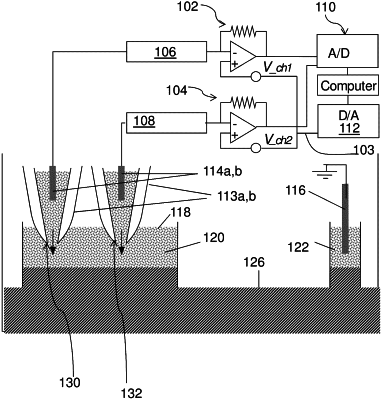| CPC G01N 27/42 (2013.01) [G01N 27/4035 (2013.01); G01N 33/48707 (2013.01)] | 13 Claims |

|
1. A device for specific detection of a plurality of analytes in a sample, the device comprising:
a flow chamber comprising:
a plurality of capillary nanopipettes,
each capillary nanopipette comprising:
a tip with a 10 nm-100 nm diameter, wherein the tip is positioned in the flow chamber for contacting a sample flowing through the flow chamber;
a coating of an analyte-binding peptide at the tip, wherein the analyte-binding peptide specifically binds to an analyte;
an electrode positioned in an interior volume of the capillary nanopipette and in contact with an electrolyte solution contained in the interior volume,
a current detecting circuit connected to the electrode in each capillary nanopipette for detecting current through the tip;
an electrode positioned in the flow chamber outside of the nanopipettes for contacting the sample and connected to the current detecting circuit;
an amplifier connected to each of the electrodes in the capillary nanopipettes and configured to apply an alternating voltage to each of the electrodes thereby producing positive and negative currents, and the current detecting circuit configured to detect both of the positive and negative currents,
wherein upon binding of an analyte in the sample to the tip of a capillary nanopipette both the positive and negative currents from the capillary nanopipette detected by the current detecting circuit are reduced.
|